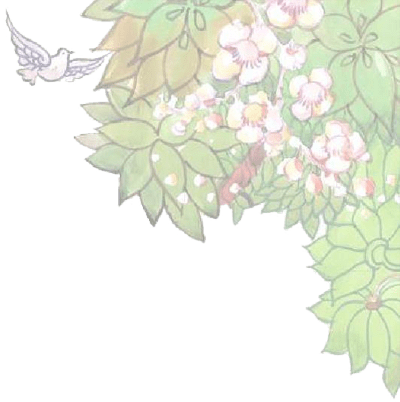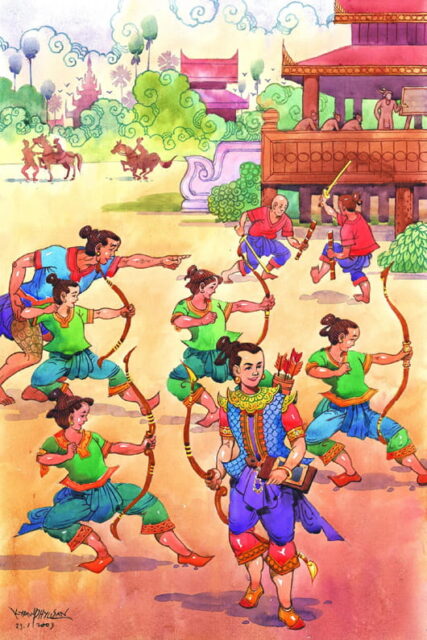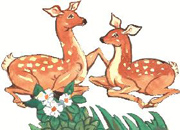07話 こども時代と教育

第1部 出家まで
第3章 王子の時代
07話 こども時代と教育

シッダッタ王子のこども時代、子守りの侍女と近習の男たちが昼も夜も最大限の世話をした。そうした従者はすべて若く、眉目うるわしく、目鼻立ちととのい、体つきのきれいな者たちだった。もし、かれらが病気になれば宮殿にいることは許されず、別の者と交代した。王子は、さまざまな種類の花飾りや香料、芳香のする装身具で、全身を飾られた。ターバン、ゆったりした筒型のチュニック上衣、下着、肩をおおうケープは、すべて最高級品の産地として知られるカーシ国から取り寄せたものだった。音楽や舞踊をする者たちは王子を楽しませようと、あらゆる妙技で終日演じた。王子がどこへ行こうと、従者は大きな日傘をかざし、一日中、陽の光が直接あたらず、埃や露で不都合が生じないようにした。
スッドーダナ王は、宮殿内に三つのハス池を家来に掘らせた。青蓮(ウッパラ)池には青いハスの花、紅蓮(パドゥマ)池には赤いハスの花、白蓮(プンダリーカ)池には白いハスの花がそれぞれ栽培され、花ひらくのだ。これらはひとえにシッダッタ王子を喜ばせるためにつくられ、美しく飾りつけられたものだった。
シッダッタ王子が七歳のとき、教育がはじまった。王がかつて王子の未来を予言させるために招いた名高い八人のバラモンが、最初の先生たちだった。かれらの知っているすべてを王子に教え終えたあと、スッドーダナ王はサッバミッタという別の先生のもとへ王子を送った。
サッバミッタ・バラモンは名高い家柄の、優れた血筋の人で、ウディッチャ地方に住んでいた。言語学者にして文法家で、バラモン教の聖典ヴェーダと、音声学、韻律学、文法学、語源学、天文学、祭式学からなる六つのヴェーダ補助学に精通していた。かれが菩薩(訳注:シッダッタ王子のこと)の二番目の先生で、たくさん生徒がいた。高貴な家柄の生徒たちだったが、菩薩はすべての科目で、他の誰よりも早く習得できた。かくして、何においてもいちばん巧みで、いちばんよくできた。全科目に非凡な成績で、先生を上回るまでになった。もっとも知力に優れ、先生や年長者にたくさん質問した。体力はクラス最強、身長も最高、いちばん眉目秀麗だった。決してなまけなかった。決して不作法な真似をせず、教師に対して決して反抗することがなかった。誰でも愛し、誰からも愛された。あらゆる種類の人びとの友であった。動物にさえ友好的で、決して害することがなかった。
王子は、決して時間をむだにすることがなかった。時間があればいつでも静かなところへ行き、冥想した。友人たちにすらいっしょに冥想するように、と勧めたが、誰もまともにとりあわず、そんな王子を笑った。
王子は武士貴族の階級に属していたので、軍事学の教育も受けた。拳闘、格闘技、剣術、馬術などの武術も練習した。弓術や武器の使い方の訓練もしたが、生きものにけがを負わせることは好まなかった。また、ウサギやシカのように無害な動物の殺生や虐待も避けた。
シッダッタはもっとも賢い生徒で、王子でもあったのだが、先生たちをないがしろにすることは絶対になく、礼儀正しく、当然払うべき尊敬を忘れなかった。先生たちの教えからのみ、人はまさに偉大な価値ある知識を獲得できる、とかれは信じていたのである。
※ 画像やテキストの無断使用はご遠慮ください。/ All rights reserved.

07 CHILDHOOD AND EDUCATION
During Prince Siddhattha’s childhood, he was looked after by nurses and men day and night with the greatest possible care. All of his attendants were young, good-looking, beautiful, handsome and of complete bodily form. If they were sick, they would not be allowed to stay in the palace and would be replaced by others. He was adorned all over with ornaments of various kinds, garlands, perfumes and scented
ornaments. His turban, tunic, lower garments and cloak were all ordered from the State of Kāsi. Musicians and dancers would all show their various skills to entertain him all day. Attendants were ordered to shade him with a great parasol wherever he went, the whole day, to protect him from the sun, dust and dews which might inconvenience him.
King Suddhodana had his men dig within the palace three lotus ponds. The Uppala Pond was peculiar for its growing and blossoming blue lotuses, the Paduma Pond for red lotuses, and the Puṇḍarīka Pond for white lotuses. These were made and beautifully decorated solely for Siddhattha’s pleasure.
When Siddhattha was seven years of age, he started his education. The eight distinguished brahmins, whom the king had invited to prophesy the future of Siddhattha, were his first teachers.
After they had taught the prince all which they knew, Suddhodana sent him to another teacher named Sabbamitta. The brahmin Sabbamitta was of distinguished descent and high lineage, living in the land of Udicca. He was a philologist and grammarian, and he was also well-read in the Vedas and the six Vedaṅgas, comprised of phonetics, prosody, grammar, exegesis, astronomy and ritual. He was the Bodhisatta’s second teacher.
There were many children in his class. These children came from noble families, but the Bodhisatta could learn all subjects faster than his classmates. Thus, he became the cleverest and the best in everything. He gained distinction in every subject and became cleverer than his teachers. He was the wisest and the only one who asked many questions to his teachers and elders. He was the strongest, the tallest and the most handsome boy in the class. He was never lazy. He never misbehaved and was never disobedient to the teachers. He loved everybody, and
everybody loved him. He was a dear friend to all kinds of people. He was even friendly to animals, never harming them.
The young prince never wasted his time. Whenever he found no work, he would go to a quiet place and practised meditation. He even tried to induce his companions to join him in practising meditation, but his friends did not consider it seriously and laughed at him.
As he belonged to the warrior class, he obtained education in the military science, too. He was trained in the martial arts, such as boxing, wrestling, fencing and horse-riding. He was also trained in archery and in the use of weapons, but he did not like inflicting injury to other beings. He also avoided killing or oppressing even harmless animals, such as rabbits and deer.
Even though Siddhattha was the cleverest pupil and was also a prince, he never neglected to treat his teachers with good manners and all due respect. He believed that only through the instruction from teachers could men acquire knowledge of very great value.
※ 画像やテキストの無断使用はご遠慮ください。/ All rights reserved.
アシン・クサラダンマ長老
1966年11月21日、インドネシア中部のジャワ州テマングン生まれ。中国系インドネシア人。テマングンは近くに3000メートル級の山々が聳え、山々に囲まれた小さな町。世界遺産のボロブドゥール寺院やディエン高原など観光地にも2,3時間で行ける比較的涼しい土地という。インドネシア・バンドゥンのパラヤンガン大学経済学部(経営学専攻)卒業後、首都ジャカルタのプラセトエイヤ・モレヤ経済ビジネス・スクールで財政学を修め、修士号を取得して卒業後、2年弱、民間企業勤務。1998年インドネシア・テーラワーダ(上座)仏教サンガで沙弥出家し、見習い僧に。詳しく見る
奥田 昭則
1949年徳島県生まれ。日本テーラワーダ仏教協会会員。東京大学仏文科卒。毎日新聞記者として奈良、広島、神戸の各支局、大阪本社の社会部、学芸部、神戸支局編集委員などを経て大阪本社編集局編集委員。1982年の1年間米国の地方紙で研修遊学。2017年ミャンマーに渡り、比丘出家。詳しく見る

※ 画像やテキストの無断使用はご遠慮ください。
All rights reserved.

